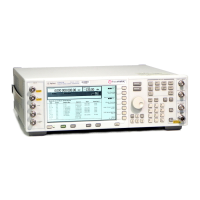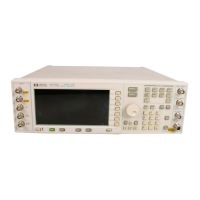296 Chapter 9
BERT
Bit Error Rate Tester–Option UN7
Special Pattern Ignore Function
The special pattern ignore function is especially useful when performing BERT analysis on radios that
generate consecutive 0’s or 1’s data for traffic channels when they fail to detect the Unique Word or lose
synchronization. If 160 or more consecutive incoming data bits are either 1’s or 0’s, and the
Spcl Pattern
Ignore Off On
softkey is set to On, then all of the consecutive 0’s or 1’s are ignored. Select either 0’s or 1’s as
the data to ignore by using the
Spcl Pattern 0’s 1’s softkey. The following figure shows an example of the
special pattern ignore function.
Figure 9-28
The 160 or more ignored bits can be anywhere in the PN sequence. The signal generator ignores these bits as
error, but they are counted in the PN sequence bit count.
Pass/Fail Judgement
There are two pass/fail judgement update modes: cycle end and fail hold. With cycle end selected, either
pass or fail judgement is made for the results of each measurement cycle. With fail hold selected, the fail
judgement is retained whenever a failure occurs during one loop of BERT repeat measurements. Fail hold
mode allows you to determine when a failure occurs at least once during an entire cycle of measurements.
Repeat Measurements
When the Cycle Count softkey is set to more than 1, the synchronization performed before the start of each
measurement is only executed the first time; then it keeps track of the clock signal and the PRBS generation
for the incoming data. This function can reduce the total time for BERT measurements. Also, once
synchronization is established, it is retained even if the BERT measurement result degrades. You may wish
to adjust the signal level to find a specific BERT value. However, once synchronization is lost in a repeat
sequence, it will not be restored until the initiation of a new sequence. The following figure shows an
example of the repeat measurements.

